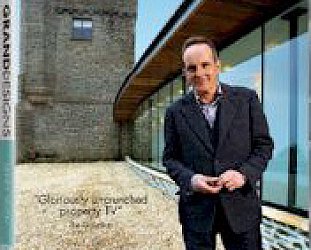Graham Reid | | 2 min read
Sir Harry Lauder: Stop yer ticking Jock (originally 1906)

Locals call it “the Armadillo” but
it's a rather obvious name for the striking building by the River
Clyde, once the heart of Glasgow shipbuilding. With a suspicious
similarity to a more squat Sydney Opera House, the Armadillo huddles
almost fearfully in the shadow the enormous, now redundant,
Finnieston Crane, a muscular reminder of the city's industrial past.
Designed by a son of this city, Sir
Norman Foster – also responsible for London's “Gherkin” and the
poetically beautiful bridge at Millau in France – the Armadillo, in
reality the Clyde Auditorium, is one of many fascinating buildings in
this Scottish city which will host the 2014 Commonwealth Games.

But there are any number of beautiful Georgian, Regency and Victorian buildings in the city.
 “Aye, there's a lot to see when you
look up,” says a passing policeman as I stand arching my back to
take in some strange embellishments on a grand old building.
“Aye, there's a lot to see when you
look up,” says a passing policeman as I stand arching my back to
take in some strange embellishments on a grand old building.
From unusual statuary to dramatically
sweeping modern bridges across the Clyde, Glasgow is a visually
surprising city. The Griffin Bar in Bath Street, not far from the Art
Deco Beresford Apartments and the red sandstone Kings Theatre, has a
beautiful Art Nouveau exterior.
But the chief attractions are buildings
and interiors designed by another hometown boy, Charles Rennie
Mackintosh (1868-1928), most famous being the Glasgow School of Art
which celebrated its century in 2009.
Although enhanced by the lightness of
Mackintosh's Art Nouveau embellishments on the outside, within the
walls are austere and solid, and the stairwells dark – but the
library (no longer in use but open for guided tours) appears to float
with a soothing lightness.
The Willow Tea Rooms on Sauchiehall
Street – lovingly recreated from the 1904 original – is where
Mackintosh designed every detail for owner/patron Kate Cranston. Tea
and cake here is a must.
At the School of Art you can purchase
all things Mackintosh from posters to books of his life and work. I
bought a lapel badge with a Mackintosh quote in his hard-to-read Art
Nouveau typeface: “There is hope in honest error, none in the icy
perfections of the mere stylist”.
I wasn't sure if that summed
up Glasgow's innovative architecture and design -- especially the
daring new buildings and those which were so in their day -- but it
seemed to.
And, being a Scot by birth and upbringing, I did note it wasn't too expensive.
For more articles on architecture start here, and on Scotland go here.







post a comment